In today’s installment of Goonhammer Historicals, we’ll be kicking off our series on the American Civil War. The four years of fighting between the Union and the Confederacy is a defining period in American history, so we’ll look at how to get started gaming this period of intense conflict
Disclaimer: The American Civil War was about slavery. All of the contemporary writings, even the very Confederate Constitution adopted by the southern states, clearly and prominently identified the preservation of slavery as the key aim of secession. For more insight about later attempts to justify secession after-the-fact, we heartily recommend you check out Nolan and Gallagher’s excellent “The Myth of the Lost Cause and Civil War History.” As such, the Confederacy are unambiguously the “bad guys,” but just like with historicals games set in the Second World War and Nazi forces, someone has to play the bad guys. You can still have engaging, enjoyable, and interesting games all while knowing the force you play represented a morally repugnant ethos. So, with that out of the way…
Why Play the American Civil War (ACW)?
To most historians the American Civil War represents the end of the “black powder” era, and like most periods of intense conflict it was a time of great technological advancement and adaptation. Cartridge-loaded revolvers were already in widespread use – most officers carried one – and by the end of the war, Union forces were deploying cartridge-fed repeating rifles in increasing numbers. The Vicksburg campaign saw the first widespread use of trench warfare, which 50 years later would come to define the First World War. The cavalry charge, a force to be reckoned with in the Napoleonic Wars, had been rendered largely obsolete thanks to the extended range and accuracy provided by the widespread use of rifled muskets. Instead, cavalry forces in the American Civil War were increasingly used to scout, screen, and stage small but disruptive raids deep into enemy territory.
Naval combat too saw tremendous technological change during the Civil War, with “ironclad” steamers changing the nature of warfare at sea. The era also saw the first operationally successful use of a submarine when the CSS Hunley sank the USS Housatonic in Charleston Harbor. Further, while blockade runners are what spring to mind for most people when they think of Civil War naval engagements, naval battles of this era weren’t limited to coastal scraps, with Confederate commerce raiders like the CSS Alabama attacking Union merchant vessels literally all over the world before finally being run down off the coast of France by the USS Kearsarge.
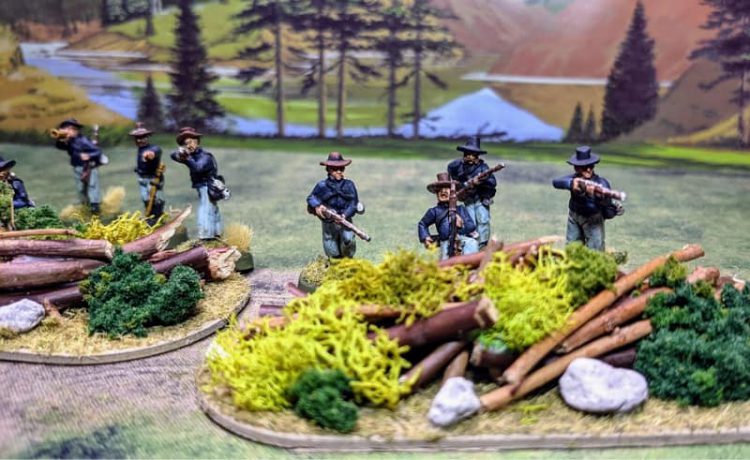
No account of the American Civil War would be complete without mentioning the larger-than-life personalities of the commanders involved. This period saw the transition from the amateur “gentleman general” (many of whom had no prior military experience before the war) to an increasingly professional officer corps made up of men formally trained in the art of war. But this transition was a painful one, and many of the battles of this era were defined as much by the personality conflicts of the general staffs as they were by the events on the field itself.
The other aspect of the American Civil War that makes it an ideal period for wargaming enthusiasts is the wide range in scales of engagement. Whether your interest lies in raids and skirmishes of a few dozen men or recreating massive battles in which literally hundreds of thousands of men took part – or anything in between – you can find ample fodder for source material. And speaking of source material, the American Civil War is an extremely well-documented conflict, making it fairly easy to determine which units were engaged or how many men were participating in any given battle. For scenario designers, this body of information is crucial and as a result there are loads of pre-written scenarios to support the major rulesets.
If you’re in the USA, there are plenty of battlefields to visit and learn as much as you like about that particular battle. Since it is a relatively recent war there are many artifacts to see in museums. Film hasn’t been as inspired by the ACW of late; the 90s were a gold mine for not only movies, but TV and documentaries. Of particular note are the films Glory, Gettysburg, and Wicked Spring; documentaries are ruled by PBS Ken Burns’ The Civil War series, and there are plenty of great shows like Civil War Combat and Civil War Journal on streaming.
You’ll also learn a lot more by wargaming the ACW than (if you’re from the USA) the few days your history teacher in high school may have spent on the war. This conflict is perhaps the defining conflict of American history; it ended the century-long conflict over legalized slavery and caused immense suffering. No other conflict in the history of the USA has caused as many casualties and property destruction as the ACW. Of course it was all for a moral and incredibly important reason – to free enslaved people.
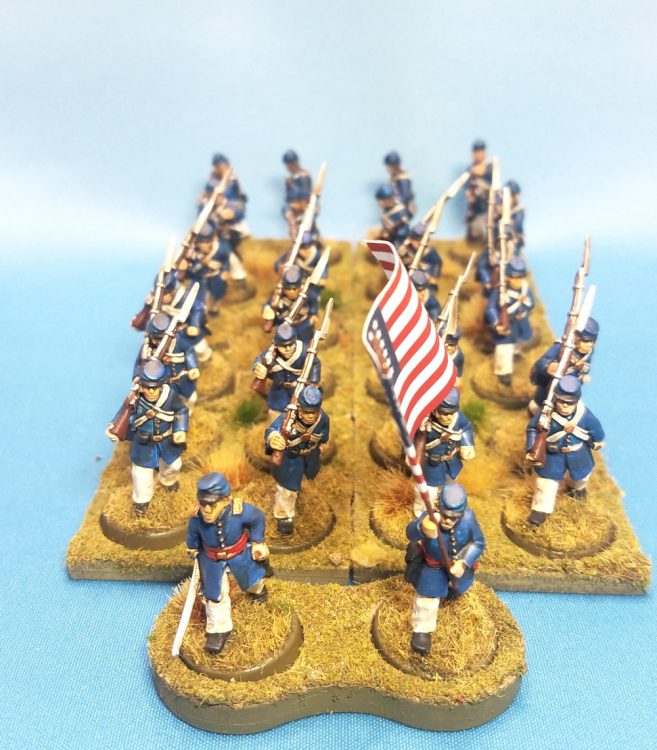
Historical Highlights
Broadly speaking, the ACW breaks down into two main theaters (the eastern and western), separated by the natural barrier of the Appalachian mountain range.
The Eastern Theater
The bulk of the fighting in the eastern theater took place in the coastal plain of Virginia, Maryland, and the Carolinas, with many of the war’s most significant battlefields being located within a 100-mile radius of Washington DC. Notable actions include:
Bull Run / First Manassas
This was the opening battle of the war, and the engagement that shook the Union public opinion that the war would be over in a matter of days or weeks. Though the number of troops engaged was small in comparison to later battles, it was still big enough to be called a proper battle and serves as a great starting point for those wanting to play actions at regimental scales. The variety of uniforms and equipment used makes for an interesting modeling and painting project.
The Peninsula Campaign
General George McClellan’s plan to work his way up the James peninsula, he boldly predicted that he would scatter the rebel armies in a series of quick strikes and take Richmond itself. Instead, his overly cautious approach led to significant dithering and a number of costly, inconclusive battles. Battles at Mechanicsville, Gaines’ Mill, Seven Pines, and Malvern Hill would ultimately force McClellan to withdraw in defeat, and his slowness to react throughout the campaign would see him saddled with the sobriquet “the Virginia Creeper.”
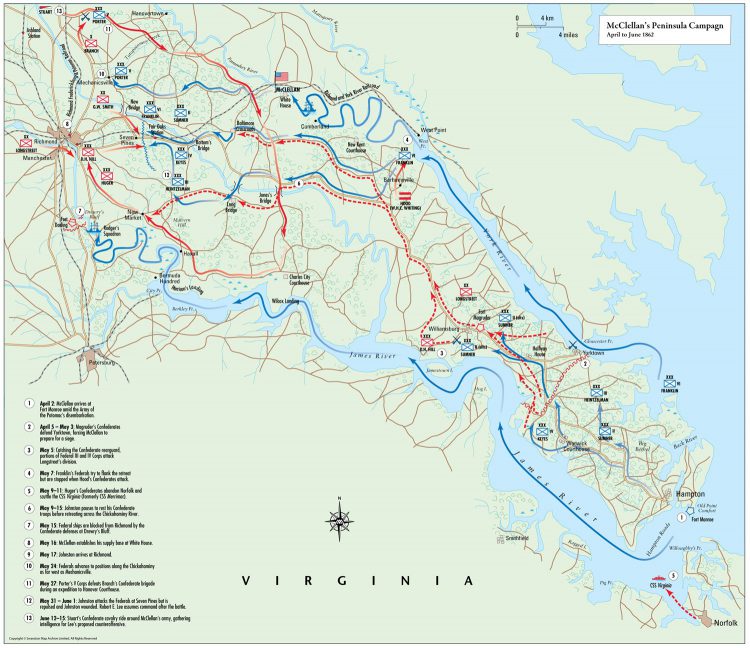
The Shenandoah Valley Campaign
The campaign that cemented the reputation of Thomas “Stonewall” Jackson, this was a series of relatively small actions that threatened Washington DC and drew a large number of Union troops on what amounted to a wild goose chase. Actions at Kernstown, Front Royal, Cross Keys, and Port Republic were sharp affairs in which nimble but outnumbered forces took on much more numerous opposition.
The Sharpsburg Campaign
Under significant political pressure to score a win on Union soil, Confederate forces under Lee moved into Maryland. Through a mysterious set of circumstances, Lee’s entire operational plan fell into Union hands, causing McClellan to move against him with uncharacteristic swiftness. A series of delaying actions allowed the Confederates to draw their scattered forces together before the Union attack came. The culmination of all of this maneuvering would be the battle of Antietam, still the single bloodiest day in American history.
Gettysburg
After forcing back a Union attack under General Hooker at Chancellorsville, Lee again attempted to take his army into Union territory, this time pushing all the way into southern Pennsylvania. Though Lee was attempting to avoid getting drawn into a protracted engagement (as he didn’t know how large the Union army was or where it was located), Confederate Corps Commander General Dick Ewell became entangled with Union cavalry on the outskirts of Gettysburg. Once battle was joined, both sides committed the entirety of their forces. The ensuing three day battle is viewed by many as the turning point of the war.
Sherman’s March To The Sea
After the sacking of Atlanta, General Sherman led a detachment of the Union Army of the Cumberland through the Confederate hinterlands. Moving almost completely unsupported and deep through enemy territory, Sherman’s army engaged in “total war,” intent on burning and destroying Confederate production and infrastructure. Ultimately Sherman was able to capture the Confederate seaport of Savannah before resupplying and turning north to cut similar swathes of destruction through the Carolinas. Shadowed by Confederate cavalry forces, the campaign saw few set-piece battles but innumerable skirmishes.
This makes it a very interesting theater to game in, as the gamer who doesn’t want to paint 5,000 minis can start small and do raiding, foraging, or rear guard actions with smaller numbers of troops. There were a number of smaller militia groups, Unionist groups, cavalry raiders etc. involved. There were also numerous US African American troops involved in skirmishes in North and South Carolina adjacent to the March, which provide another great research point.
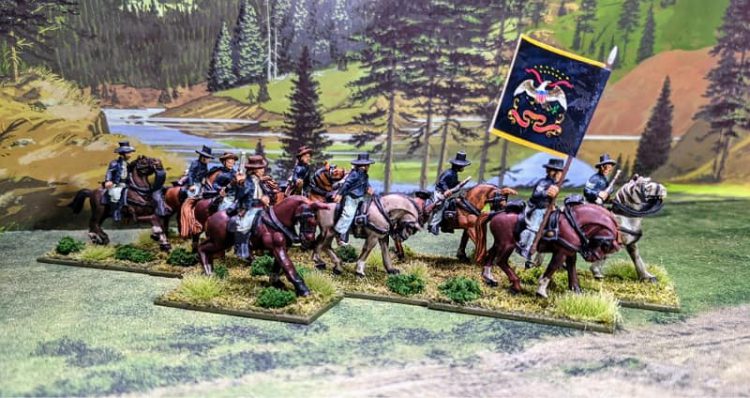
The Western Theater
Though some fighting did take place as far west as Texas, when historians say the “western” theater they’re generally talking about fighting in the Mississippi and Tennessee valleys. Important actions include:
Shiloh
The first major battle of the Western Theater saw Union forces under General Grant suffer significant losses to the Confederacy on the first day. But the Confederacy’s gains were hard won and after Confederate commander Albert Sidney Johnston was mortally wounded, the rebels did not press their attack. This proved unwise, as fresh Union reinforcements arrived overnight, allowing the Union to launch a counterattack across the entire front the following day. Though eclipsed by later battles, the two days’ fighting at Shiloh would produce more casualties than all of the previous battles in the war combined. This was the battle which confirmed that the war would not be over any time soon. The Confederate war effort in the west was pretty much doomed from this battle forward, with one or two exceptions.
The Siege of Vicksburg
The strategically critical city of Vicksburg controlled access to the lower reaches of the Mississippi River, and until it was captured Union supplies could not pass (though Union admiral David Porter’s gunboats had run the gauntlet). After a series of losses, Confederate forces under General Pemberton pulled back to the city itself. Swampy terrain and the river itself limited approaches to the city. During the two month siege Grant’s army dug over 15 miles of trench works and subjected the city to near constant bombardment. Vicksburg was captured by the Union while the battle of Gettysburg was being fought in the eastern theater, giving the Union two major victories on the same day. Gamers looking for entrenchments, ironclads, and huge artillery pieces should definitely check out this siege.
Chickamauga
The battle of Chickamauga was the result of the William Rosecrans’ Army of the Cumberland and Braxton Bragg’s Army of Tennessee stumbling blindly around the hill country of north Georgia before blundering into each other. Both sides sought to engage only portions of their opponent’s army and force a defeat in detail, but in the end the main bodies of both armies fought head-on. Taking place in extremely difficult terrain, the battle of Chickamauga was a pyrrhic victory for the Confederacy – the Union Army was forced to cede the field, but Confederate losses prevented them from following up and recapturing the strategic city of Chattanooga.
The timely arrival of Longstreet’s veteran corps from Virginia via 900+ miles of railroad, launching them into combat within hours of arrival provides a very interesting dichotomy – the failing Army of Tennessee with the veteran Longstreet’s corps that had won many battles. The two forces would be clothed differently as well, with Longstreet’s boys mostly wearing cadet grey (almost a blue) shell jackets and using ANV flags, while AOT would have had mostly wool jean gray and AOT flags.
The federal army really provides some great modelling and research efforts at Chickamauga – George Thomas, a Virginian, held the Confederate tide back and arguably saved the Union army in the west here. He would afterward be known as ‘The Rock of Chickamauga’. Wilder’s Lightning Brigade were infantry who were mounted on horses for mobility and purchased their own Spencer repeating rifles.

Atlanta
The siege and eventual capture of the city of Atlanta was the result of a brilliant campaign of maneuver by Union General William Tecumseh Sherman. By engaging in a series of smaller battles which attacked the supply lines leading into the city rather than trying to force his way into the city itself, Sherman forced the Confederates under General John Bell Hood to abandon the city. This would set the stage for Sherman’s infamous “March to the Sea.”
Nashville
After being pushed out of Atlanta, Confederate General Hood led his army on an invasion of Tennessee, with the intent of retaking the parts of that state now lost to the Union. This campaign is considered by many to be the “last gasp” of Confederate hopes in the west. After suffering heavy casualties in pushing the Union out of its defenses at Franklin, the Confederate Army of Tennessee was smashed and routed at the battle of Nashville. This campaign marks the last of the major battles in the western theater.
What Games Should I Play?
Here are a handful of the most popular games designed for use in the American Civil War era. Keep in mind that there are literally dozens of games focused on the Civil War, but these are a good sampling of those which are most accessible, popular, modern, or just best-liked by the Goonhammer Historicals team.
Sharp Practice 2 by Too Fat Lardies

You always know that a ruleset by the Too Fat Lardies is going to top our list for almost any given era, and the American Civil War is no exception. Though more geared towards skirmish play than large, set-piece battles, Sharp Practice none the less delivers a fantastic game-play experience even in larger engagements. With their perennial emphasis on the “friction” of warfare, the Lardies do a really good job at capturing the difficulty in exercising command and control over one’s forces. Unit rosters and army lists for the American Civil War are given in the main book, so Sharp Practice is “one stop shopping” for those looking to get into the period.
When playing SP, we definitely recommend creating your own campaign as TFL games are well-suited to campaign play; but also creating your own regiments and commanders to create stories from. This allows you to have some leeway in terms of historical accuracy and the smaller sizes of the forces involved.
While Sharp Practice uses individual casualty removal to track unit losses, it is largely scale-agnostic; I play it in 15mm, and mugginns plays in 28mm. He’s done a great review of the game for Goonhammer Historicals, which I encourage you to check out. If you’re looking for a way to get into the period for relatively little investment, skirmishes and smaller scale engagements are a great way to ease in. These excellent rules are available from the Too Fat Lardies webstore.
Gettysburg Soldiers by Gettysburg Soldiers

This was the ruleset that first got me into historical wargaming. It is explicitly a 15mm system, with a ground scale of 1” to 25 yards and one “stand” of figures (three or four figures on a roughly 1” square base) representing roughly 50 men. The basic unit is the regiment – usually comprised of four to ten stands each – and you’ll likely have several regiments on each side. Casualty removal is by entire stands, so it’s easy to apply. The rules are incredibly quick to learn and simple to play, with the rulebook being a small, spiral-bound folio that conveniently spreads out with the reference tables in the middle, meaning all of the important rules are immediately visible. I wish more rulesets did this! If you’re looking for a quick way to get into the period, I highly recommend this system.
Gettysburg Soldiers (the company) is a small, 2-man outfit and their website is a little tough to navigate in terms of buying things, but the main page for their rules is available here.
Regimental Fire & Fury by Fire & Fury Games
Considered by many to be one of the defining “grand tactical” rulesets, Regimental Fire & Fury is unsurprisingly geared towards regimental scale battles. It generally assumes multi-figure bases, with casualties and unit conditions tracked with markers. The game is much “crunchier” than some of the other offerings here, so there’s more stuff to consider (such as if a unit is fresh, worn, or spent, each of which will affect its capabilities in combat). Artillery has a lot of nuance in this game, so if you like being able to distinguish the difference between a 10-lb Parrot Rifle and a 12-lb Smoothbore Napoleon – distinctions that were often important in the battles of the era – this might be your game.
A nice thing about Regimental Fire & Fury is that the basing recommendations are the same as for the larger version of the game, Brigade Fire & Fury. This is cool because as your collection grows you can transition smoothly to larger engagements with a ruleset that will feel very familiar.
You can get Regimental Fire and Fury here. Of special mention are the laminated card-stock Quick Reference Sheets, which are absolutely worth getting. As a rank newbie playing the game for the first time at GenCon, I found these very helpful and intuitive.
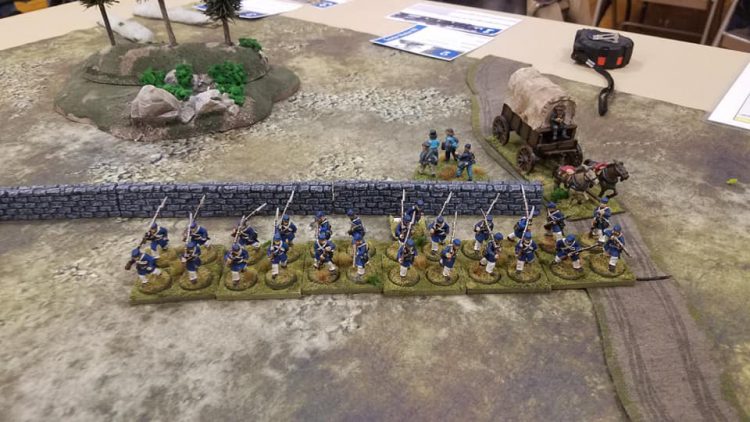
Pickett’s Charge by Reisswitz Press
Reisswitz Press is the sister publishing house to Too Fat Lardies, and is run by veteran game designer Dave Brown. Dave very much agrees with the Lardies’ focus on command and control and friction, and Pickett’s Charge does for the American Civil War what his earlier ruleset General d’Armee does for the Napoleonic Era – namely allow you to fight whopping huge battles! The basic unit of action is the brigade, meaning that you’ll be able to recreate engagements at the division and even corps unit scales. The system uses a clever mechanic where each player’s command and control resources are not constant, which beautifully recreates the barely-managed chaos of attempting to command large groups of men on a noisy battlefield in an era long before radios were invented. Like Regimental Fire & Fury, Pickett’s Charge is a more complicated ruleset, with a level of detail in its mechanics that is a little bit more intense to play but which captures more of the nuance of the period.
As a related company Reisswitz Press runs their store under the Too Fat Lardies banner, so you can get Pickett’s Charge here.

Ironclads by Scary Biscuit Studios
Naval wargaming has always been a bit of an enigma to this wargamer (muggins) because a lot of the rulesets seem very, very complex. Tables, charts, wind, damage tracking, etc make it seem like you need a degree in naval warfare and accounting to play. I’ve purchased and read a number of rulesets, and think I’ve found a few I’d like, but Ironclads by Scary Biscuit Studios really jumped out at me. Right now it’s free and in beta testing, but the materials are top-notch even with that.
You can use whatever scale you like but I believe they’re mostly written for 1:600 scale Ironclads, Cottonclads, Tinclads, and whatever other clad you want. The rules are only actually about a dozen pages, and the author already has stats for dozens of ships from the period. The game is simple but strategic, and not ‘easy play’ in terms of roll dice and forget. It is definitely worth checking out here.
What Miniatures Should I Buy?
Oh, man, where to even start? There are so many manufacturers of American Civil War miniatures that it’s head-spinning. Here are just a few that we like, but rest assured that if you get into the period, you will be spoiled for choice at almost any scale.
Perry Miniatures (28mm)

If you want affordable, high-quality sculpts in 28mm scale, Perry Miniatures once again set the bar. Their “Battle in a Box” is an insanely good deal, and includes 145 Infantry, 12 Cavalry, 4 Artillery Pieces, and 18 Crew for just £95 (roughly $130 as of this writing). It’s enough to give both sides a decent force right from the jump, which is great. For those who want a more measured approach, their basic infantry boxes are generally around 40 plastic figures for £20 pounds. Their plastic offerings are supplemented by a huge range of metal figures for commanders, drummers, cannon crews and even basic infantry in variant uniforms. Want your Confederate infantry in shell jackets and wearing kepis instead of frock coats and slouch hats? Fear not, the Perry brothers have you covered. They even have a British Intervention Force for an imaginary scenario where the British come down from Canada to fight with either side.
You can check out their entire American Civil War range here.
Warlord Games EPIC ACW (13mm)
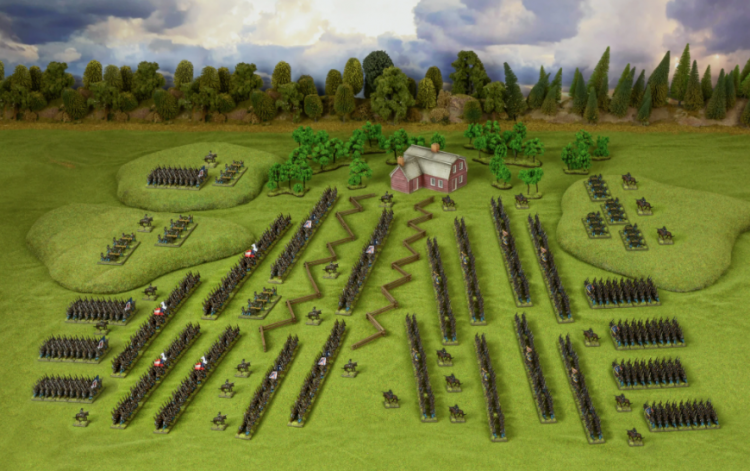
While Warlord Games act as a reseller for Perry in 28mm to support their Black Powder ruleset (which can also be used to game battles in this period), they have recently embarked on an entirely new venture with their “EPIC Battles” series, and the American Civil War is their first offering. And when they say “epic,” they’re not kidding – the starter set contains 12 regiments for each of the two sides, and a “regiment” here is five stands of 20 figures each. But to make assembly easy, those 20 figures are two lines of 10 men each, all connected and standing shoulder-to-shoulder.
Though the scale is somewhat odd at 13mm, those who have looked at the minis first-hand say they’re a good fit for Pendraken’s 12mm line, so if you want to mix in troops from at least one other manufacturer you shouldn’t have any issues. Figures that are this small paint up very quickly, so getting a very large force on the table at this scale is pretty easy. The set also includes 12 cannon for each side, a handful of mounted commanders, and some MDF fences and a barn. And at $120, it’s tough to beat in terms of value. The one weakness is the lack of cavalry, but I suspect that will not be long in coming. The models themselves are well sculpted and proportioned – something that many of the existing lines fall down on.
You can grab this ridiculous cornucopia of troops directly from Warlord Games’ webstore here.
AB Miniatures (Eureka USA) (15-18mm)
For many years, Anthony Barton (the “AB” of AB Miniatures) set the standard for historical wargames sculpts. These metal figures offer dynamic poses and a surprising amount of detail given that they’re so small. While they are nominally sold as 15mm, in reality they’re a little bigger, more on the 18mm side. But they look great and have loads of options. Even if you plan to go with a cheaper option for the bulk of your troops, I would highly recommend AB sculpts for your leaders and special troops like musicians and standard bearers – stand-out figures where the extra character and detail are warranted.
In the US, AB miniatures are distributed by Eureka Miniatures, which you can find here.
Battle Honors (Old Glory) (15-18mm)
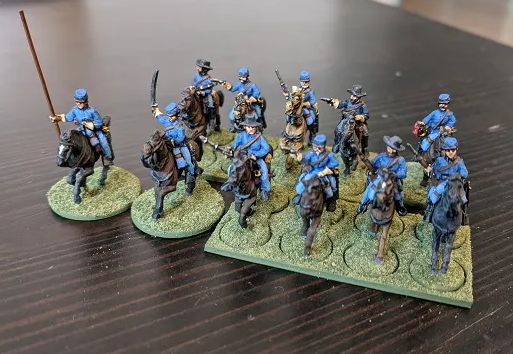
If you want to bulk out a 15mm-18mm American Civil War army inexpensively, you can’t go wrong with Battle Honors. This is a rebranding of the Old Glory 15mm metal range, and is a great way to get a lot of dudes on the table quickly. While they obviously can’t hold a candle to Warlord’s most recent offering in terms of price-per-figure (a limitation of metal over plastic), the fact that you can get a bag of 50 dudes for $22 is a pretty good deal.
The one limitation I’ve found with Battle Honors miniatures is the standard bearers. I don’t know who decided that tiny, spindly pewter standard poles were a good idea for 15mm miniatures, but poles that small and thin are notoriously bendy. I always replace the poles with steel wire (which requires a little bit of careful cutting and drilling), and the result is much more durable.
Battle Honors miniatures are available from their webstore.
Baccus Miniatures (6mm)
If you want to play truly huge battles, that usually means truly tiny miniatures, and arguably no one does tiny miniatures better than Baccus. They have an extensive range of 6mm miniatures for the American Civil War, and offer bundles for folks wanting to assemble a decent sized force quickly. 6mm miniatures paint up amazingly quickly, and this is a great way to get really impressive looking armies in a hurry. You can see Baccus’ entire 6mm ACW range here.
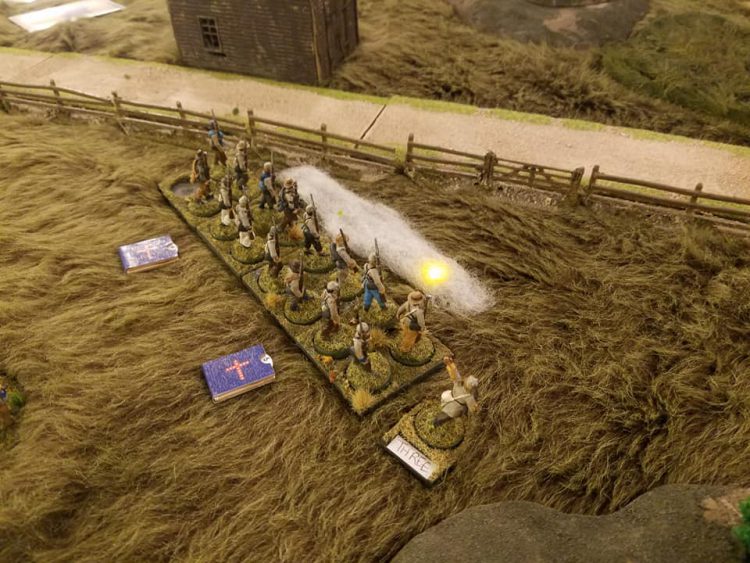
Sash and Saber Miniatures (25-28mm)
A good way to get started is to throw down for a plastic Perry force and then salt in some pewter models, and you definitely can’t go wrong with Sash and Saber. These are high-quality sculpts of many mainstream units with some specialist uniforms or units sculpted as well. They fit perfectly with Perry and many other manufacturers. Of particular note are their African American troops, Wilder’s Lightning Brigade, and Confederate Mounted Cherokee Rifles. Check out their models here.
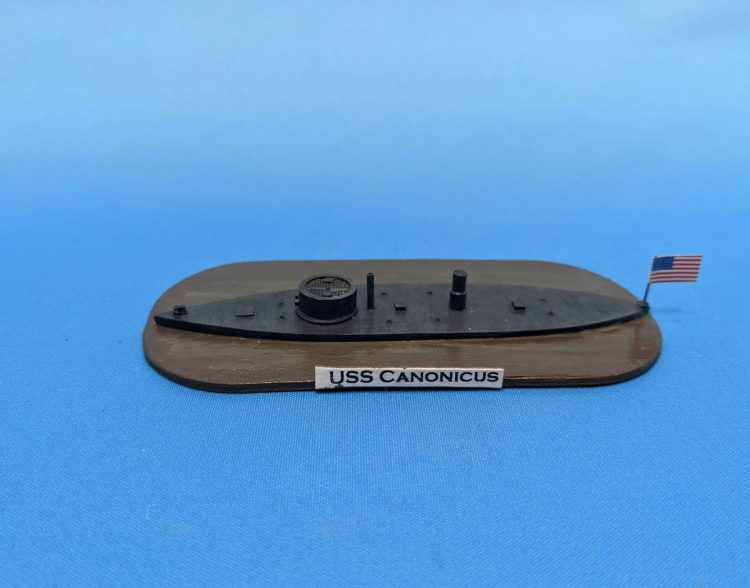
Thoroughbred Miniatures (1:600 Ironclads)
There are a few sources of miniatures for Ironclads out there, and scales range from 1:600 to 1:1200, but we recommend Thoroughbred for their 1:600 Ironclads. They have a huge range and the models are very well sculpted – some models at this scale can be a little lacking in detail but these are extremely crisp. They’re well priced and creating a fleet is not a huge outlay. Check them out here.
Where to go from here…
Over the next few weeks we’ll continue our series with more articles about various aspects of ACW gaming, including deeper dives into some of our favorite miniatures, rules reviews, and “How to Paint Everything” articles focused on the forces you’ll be fielding in your tabletop ACW battles.
Have any questions or feedback? Drop us a note in the comments below or email us at contact@goonhammer.com.



